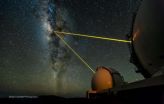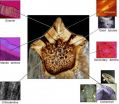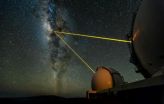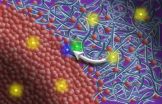(Press-News.org) UCLA astronomers report the discovery of a remarkable star that orbits the enormous black hole at the center of our Milky Way galaxy in a blistering 11-and-a-half years — the shortest known orbit of any star near this black hole.
The star, known as S0-102, may help astronomers discover whether Albert Einstein was right in his fundamental prediction of how black holes warp space and time, said research co-author Andrea Ghez, leader of the discovery team and a UCLA professor of physics and astronomy who holds the Lauren B. Leichtman and Arthur E. Levine Chair in Astrophysics.
The research is published Oct. 5 in the journal Science.
Before this discovery, astronomers knew of only one star with a very short orbit near the black hole: S0-2, which Ghez used to call her "favorite star" and whose orbit is 16 years. (The "S" is for Sagittarius, the constellation containing the galactic center and the black hole).
"I'm extremely pleased to find two stars that orbit our galaxy's supermassive black hole in much less than a human lifetime," said Ghez, who studies 3,000 stars that orbit the black hole, and has been studying S0-2 since 1995. Most of the stars have orbits of 60 years or longer, she said.
"It is the tango of S0-102 and S0-2 that will reveal the true geometry of space and time near a black hole for the first time," Ghez said. "This measurement cannot be done with one star alone."
Black holes, which form out of the collapse of matter, have such high density that nothing can escape their gravitational pull, not even light. They cannot be seen directly, but their influence on nearby stars is visible and provides a signature, said Ghez, a 2008 MacArthur Fellow.
Einstein's theory of general relativity predicts that mass distorts space and time and therefore not only slows down the flow of time but also stretches or shrinks distances.
"Today, Einstein is in every iPhone, because the GPS system would not work without his theory," said Leo Meyer, a researcher in Ghez's team and lead author of the study. "What we want to find out is, would your phone also work so close to a black hole? The newly discovered star puts us in a position to answer that question in the future."
"The fact that we can find stars that are so close to the black hole is phenomenal," said Ghez, who also directs the UCLA Galactic Center Group. "Now it's a whole new ballgame, in terms of the kinds of experiments we can do to understand how black holes grow over time, the role supermassive black holes play in the center of galaxies, and whether Einstein's theory of general relativity is valid near a black hole, where this theory has never been tested before. It's exciting to now have a means to open up this window.
"This should not be a neighborhood where stars feel particularly welcome," she added. "But surprisingly, it seems that black holes are not as hostile to stars as was previously speculated."
Over the past 17 years, Ghez and colleagues have used the W.M. Keck Observatory, which sits atop Hawaii's dormant Mauna Kea volcano, to image the galactic center at the highest angular resolution possible. They use a powerful technology, which Ghez helped to pioneer, called adaptive optics to correct the distorting effects of the Earth's atmosphere in real time. With adaptive optics at the Keck Observatory, Ghez and her colleagues have revealed many surprises about the environments surrounding supermassive black holes, discovering, for example, young stars where none were expected and seeing a lack of old stars where many were anticipated.
"The Keck Observatory has been the leader in adaptive optics for more than a decade and has enabled us to achieve tremendous progress in correcting the distorting effects of the Earth's atmosphere with high–angular resolution imaging," Ghez said. "It's really exciting to have access to the world's largest and best telescope. It is why I came to UCLA and why I stay at UCLA."
In the same way that planets orbit around the sun, S0-102 and S0-2 are each in an elliptical orbit around the galaxy's central black hole. The planetary motion in our solar system was the ultimate test for Newton's gravitational theory 300 years ago; the motion of S0-102 and S0-2, Ghez said, will be the ultimate test for Einstein's theory of general relativity, which describes gravity as a consequence of the curvature of space and time.
"The exciting thing about seeing stars go through their complete orbit is not only that you can prove that a black hole exists but you have the first opportunity to test fundamental physics using the motions of these stars," Ghez said. "Showing that it goes around in an ellipse provides the mass of the supermassive black hole, but if we can improve the precision of the measurements, we can see deviations from a perfect ellipse — which is the signature of general relativity."
As the stars come to their closest approach, their motion will be affected by the curvature of spacetime, and the light traveling from the stars to us will be distorted, Ghez said.
S0-2, which is 15 times brighter than S0-102, will go through its closest approach to the black hole in 2018.
The deviation from a perfect ellipse is very small and requires extremely precise measurements. Over the last 15 years, Ghez and her colleagues have dramatically improved their ability to make these measurements.
Co-authors on the research include Mark Morris, a professor of physics and astronomy at UCLA, and Eric Becklin, UCLA professor emeritus of physics and astronomy.
Ghez's research
In 1998, Ghez answered one of astronomy's most important questions, showing that a monstrous black hole resides at the center of our Milky Way galaxy, some 26,000 light-years away from Earth, with a mass approximately 4 million times that of the sun. The question had been a subject of raging debate among astronomers for more than a quarter of a century.
In 2000, she and colleagues reported that for the first time, astronomers had seen stars accelerate around the supermassive black hole. Their research demonstrated that three stars had accelerated by more than 250,000 mph a year as they orbited the black hole. The speed of S0-102 and S0-2 should also accelerate by more than 250,000 mph at their closest approach, Ghez said.
In 2003, Ghez reported that the case for the Milky Way's black hole had been strengthened substantially and that all of the proposed alternatives could be excluded. In 2005, she and her colleagues took the first clear picture of the center of the Milky Way, including the area surrounding the black hole, using laser guide star adaptive optics technology at the Keck Observatory.
"The pivotal research by Ghez's UCLA group using the Keck Observatory has evolved from proving that a supermassive black hole exists in the center of our galaxy to testing the very fundamentals of physics," said Taft Armandroff, director of the W.M. Keck Observatory. "This is truly an exciting time in astronomy."
Ghez's research program currently receives its primary funding from the National Science Foundation, the Keck Foundation, the MacArthur Foundation, and the Lauren B. Leichtman and Arthur E. Levine Family Foundation, with additional funding from the Preston Family Endowed Graduate Fellowship in Astrophysics (supported by Howard and Astrid Preston), the Janet Marott Student Travel Awards, and the Gordon Binder Post-doctoral Fellowship. Significant funding was also provided by the Packard Foundation for early stages of this work.
Ghez is the first woman to receive the prestigious Crafoord Prize from the Royal Swedish Academy of Sciences, which she was awarded this May.
INFORMATION:
UCLA is California's largest university, with an enrollment of more than 40,000 undergraduate and graduate students. The UCLA College of Letters and Science and the university's 11 professional schools feature renowned faculty and offer 337 degree programs and majors. UCLA is a national and international leader in the breadth and quality of its academic, research, health care, cultural, continuing education and athletic programs. Six alumni and five faculty have been awarded the Nobel Prize.
For more news, visit the UCLA Newsroom and follow us on Twitter.
UCLA astronomers discover star racing around black hole at center of our galaxy
Discovery crucial to revealing fabric of space and time around black hole
2012-10-05
ELSE PRESS RELEASES FROM THIS DATE:
Climate sceptics more prominent in UK and US media
2012-10-05
Climate sceptics are being given a more prominent, and sometimes uncontested, voice in UK and US newspapers in contrast to other countries around the world, new research suggests.
The findings have been published today, 5 October, in IOP Publishing's journal Environmental Research Letters, as part of a study looking at how climate scepticism manifested itself in the print media of the US, UK, Brazil, China, India and France during a 3-month period which included 'Climategate' in 2009/10 and a second period which covered the IPCC's Fourth Assessment Report in 2007.
In ...
Maths sheds light on what delays in getting pregnant means for prospects of having a baby
2012-10-05
A new mathematical method can help to predict a couple's chances of becoming pregnant, according to how long they have been trying.
The model may also shed light on how long they should wait before seeking medical help.
For example, the researchers have found that, if the woman is aged 35, after just six months of trying, her chance of getting pregnant in the next cycle is then less than 10 per cent.
The analysis, developed at Warwick Medical School at the University of Warwick and the London School of Economics, uses the number of menstrual cycles over which the ...
Plants adapt their defenses to the local pest community
2012-10-05
Herbivorous insects, such as aphids, damage plants and can substantially reduce yields in agricultural settings; however, they can play a major role in maintaining genetic diversity. Ecologists Tobias Züst and Lindsay Turnbull from the University of Zurich together with colleagues from California and Great Britain demonstrated the importance of variation in herbivore communities using the model plant, Arabidopsis thaliana, also known as wall cress. According to Züst, the work is one of the first experimental confirmations of a forty-year-old theory that herbivorous insects ...
Duck-bill dinosaurs had plant-pulverizing teeth more advanced than horses
2012-10-05
A team of paleontologists and engineers has found that duck-billed dinosaurs had an amazing capacity to chew tough and abrasive plants with grinding teeth more complex than those of cows, horses, and other well-known modern grazers. Their study, which is published today in the journal Science, is the first to recover material properties from fossilized teeth.
Duck-bill dinosaurs, also known as hadrosaurids, were the dominant plant-eaters in what are now Europe, North America, and Asia during the Late Cretaceous about 85 million years ago. With broad jaws bearing as many ...
Medication use higher among overweight, obese kids
2012-10-05
(Edmonton) Overweight children are far more likely to take prescription medications than children of a normal weight—a trend that adds to already higher health-care costs for treating childhood obesity, according to new research from the University of Alberta.
Researchers from the School of Public Health analyzed the medication use of more than 2,000 Canadian children through the 2007 to 2009 Canadian Health Measures Survey. They found that overweight and obese kids aged 12 to 19 years were 59 per cent more likely than their normal-weight peers to take prescription medication.
Co-author ...
TMT will take discoveries of stars orbiting the Milky Way's monster black hole to the next level
2012-10-05
Researchers have discovered a star that whips around the giant black hole at the center of our galaxy in record time, completing an orbit every 11.5 years. The finding, appearing today in the journal Science, points ahead to groundbreaking experiments involving Einstein's general theory of relativity. Those tests will be fully enabled by the Thirty Meter Telescope (TMT), slated to begin observations next decade.
The record-setting star, called S0-102, was detected with the twin 10-meter telescopes at the W.M. Keck Observatory in Hawaii. For the past 17 years, the telescopes ...
Story tips from the Department of Energy's Oak Ridge National Laboratory, October 2012
2012-10-05
ELECTRICITY-- Spotlight on outages . . .
When a storm knocks out power, among the first questions to be answered are how many people are affected and when electricity will be restored. Oak Ridge National Laboratory's Energy Awareness and Resiliency Standardized Services application, or EARSS, uses publicly available data and can help by showing grid status in real time. The goal is to enhance situational awareness for the emergency response community, according to EARSS co-developer Steve Fernandez of ORNL's Computational Sciences and Engineering Division. "Working from ...
Researchers find ancient carbon resurfacing in lakes
2012-10-05
RICHMOND, Va. (Oct. 4, 2012) – A new study reveals that a significant amount of carbon released into the atmosphere from lakes and rivers in Southern Québec, Canada, is very old – approximately 1,000 to 3,000 years old – challenging the current models of long-term carbon storage in lakes and rivers.
Previous studies have suggested that there is a tight coupling between the terrestrial and aquatic environment such that aquatic bacteria rapidly consume modern carbon. The new findings of the respiration of old carbon in aquatic systems suggests there may be significant lags ...
Northern conifers youngest of the species
2012-10-05
New Haven, Conn.—Dramatic shifts in the planet's climate and geography over millions of years changed the course of evolutionary history for conifer trees, according to a Yale paper in the Proceedings of the National Academy of Sciences.
Yale researchers examined the fossil record and genetic makeup of 489 out of more than 600 living conifer species and discovered that while most conifers belong to ancient lineages, most Northern Hemisphere species, including the majority of pines and spruces, appeared within the past 5 million years.
They argue that the migration ...
Researchers reveal how solvent mixtures affect organic solar cell structure
2012-10-05
Controlling "mixing" between acceptor and donor layers, or domains, in polymer-based solar cells could increase their efficiency, according to a team of researchers that included physicists from North Carolina State University. Their findings shed light on the inner workings of these solar cells, and could lead to further improvements in efficiency.
Polymer-based solar cells consist of two domains, known as the acceptor and the donor layers. Excitons, the energy particles created by solar cells, must be able to travel quickly to the interface of the donor and acceptor ...
LAST 30 PRESS RELEASES:
Making lighter work of calculating fluid and heat flow
Normalizing blood sugar can halve heart attack risk
Lowering blood sugar cuts heart attack risk in people with prediabetes
Study links genetic variants to risk of blinding eye disease in premature infants
Non-opioid ‘pain sponge’ therapy halts cartilage degeneration and relieves chronic pain
AI can pick up cultural values by mimicking how kids learn
China’s ecological redlines offer fast track to 30 x 30 global conservation goal
Invisible indoor threats: emerging household contaminants and their growing risks to human health
Adding antibody treatment to chemo boosts outcomes for children with rare cancer
Germline pathogenic variants among women without a history of breast cancer
Tanning beds triple melanoma risk, potentially causing broad DNA damage
Unique bond identified as key to viral infection speed
Indoor tanning makes youthful skin much older on a genetic level
Mouse model sheds new light on the causes and potential solutions to human GI problems linked to muscular dystrophy
The Journal of Nuclear Medicine ahead-of-print tip sheet: December 12, 2025
Smarter tools for peering into the microscopic world
Applications open for funding to conduct research in the Kinsey Institute archives
Global measure underestimates the severity of food insecurity
Child survivors of critical illness are missing out on timely follow up care
Risk-based vs annual breast cancer screening / the WISDOM randomized clinical trial
University of Toronto launches Electric Vehicle Innovation Ontario to accelerate advanced EV technologies and build Canada’s innovation advantage
Early relapse predicts poor outcomes in aggressive blood cancer
American College of Lifestyle Medicine applauds two CMS models aligned with lifestyle medicine practice and reimbursement
Clinical trial finds cannabis use not a barrier to quitting nicotine vaping
Supplemental nutrition assistance program policies and food insecurity
Switching immune cells to “night mode” could limit damage after a heart attack, study suggests
URI-based Global RIghts Project report spotlights continued troubling trends in worldwide inhumane treatment
Neutrophils are less aggressive at night, explaining why nighttime heart attacks cause less damage than daytime events
Menopausal hormone therapy may not pose breast cancer risk for women with BRCA mutations
Mobile health tool may improve quality of life for adolescent and young adult breast cancer survivors
[Press-News.org] UCLA astronomers discover star racing around black hole at center of our galaxyDiscovery crucial to revealing fabric of space and time around black hole





